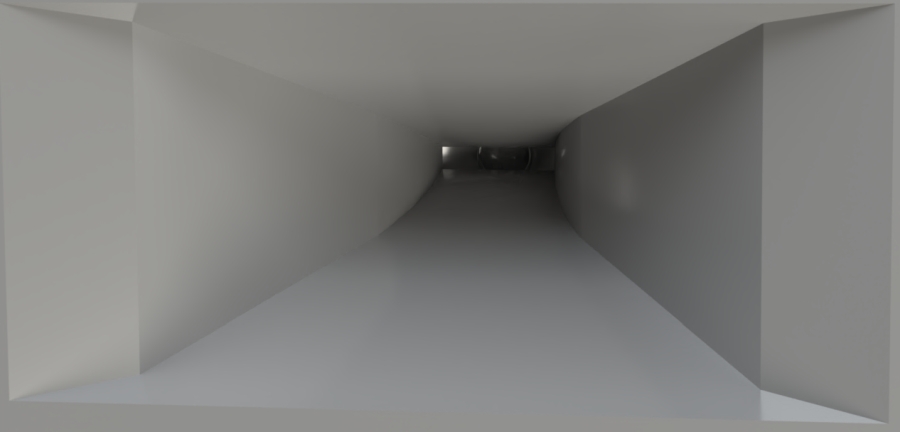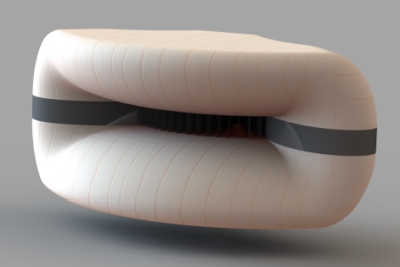Mid-range beaming and narrowing
The Challenge of Midrange Response
In loudspeaker design, achieving a smooth and balanced frequency response across the entire spectrum is a continuous pursuit. One specific challenge lies in the midrange frequencies (typically around 1 kHz).
Here, two unwanted phenomena can significantly impact the sound and his power response: midrange narrowing and beaming.
Here we can see a not fully optimised end of profile resulting a narrowed mid-range in 1kHz region :

Whatever the horn, wageguide, integrated on baffle or not, the contour must be fluid in all directions.


Midrange Narrowing: A Dip Caused by Diffraction
Midrange narrowing refers to a decrease in sound pressure at specific midrange frequencies.
This occurs due to edge diffraction. When sound waves traveling from the driver encounter the sharp edges of the speaker baffle, they bend around these obstacles.
This bending disrupts the wavefront, causing destructive interference at certain wavelengths (frequencies). These wavelengths correspond to the dip observed in the midrange response of the speaker, affecting both on-axis and off-axis.
Here is an exemple about how to solve it:
Midrange Beaming: Uneven Radiation Due to Diffraction
While midrange narrowing represents a loss of sound pressure, another effect of edge diffraction is midrange beaming. This phenomenon describes the concentration of sound pressure in specific off-axis directions.
The bending of sound waves can lead to constructive interference at certain angles, resulting in peaks in the off-axis response. However, in other off-axis locations, destructive interference can occur, causing dips.
This creates an uneven sound radiation pattern, compromising the overall soundstage and affecting listeners at various positions.
The Impact on Listening Experience
The combined effects of midrange narrowing and beaming can significantly alter the way we perceive sound. Here’s how:
-
Reduced Clarity: The dip in the midrange response, even on-axis, can weaken the presence of vocals, instruments playing in this frequency range (guitars, pianos), and essential details in the overall sound.
-
Uneven Tonality: The variations in sound pressure across the entire response (on and off-axis) can lead to an unbalanced listening experience, where the sound might appear brighter or duller depending on the listener’s position relative to the speaker.
-
Narrowed Soundstage: The uneven off-axis response can restrict the perceived width and depth of the soundstage, making the sound seem less immersive for listeners positioned off-axis.
-
Compromised Power Response: The ideal combination of direct sound from the speaker and reflected sound from the room (reverberant field) at the critical distance (the distance where these two components are roughly equal) is crucial for a natural listening experience. Midrange narrowing and beaming can disrupt this balance, affecting the perceived loudness and fullness of the sound.
Optimizing Baffle Design for Smooth Midrange
To address these challenges and achieve a smooth midrange response, loudspeaker designers employ various strategies:
-
Round-Over Returns and Sharp Edges removing: A smooth, curved transition where the horn profile meets the baffle minimizes disruptions to the wavefront, reducing both midrange narrowing and beaming. Finding the ideal radius for the round-over depends on the specific horn profile. It requires balancing diffraction reduction with practicality.
-
Fluid Profile Integration: Seamless integration of the horn with the baffle is crucial. The combined profile should be continuous and avoid abrupt transitions on both the front and side of the baffle, minimizing opportunities for edge diffraction.
-
Horn and Baffle as One: Ideally, the design strives for the horn and baffle to function as a single unit with a continuous profile. This ensures optimal wavefront propagation and minimizes diffraction effects.
For flat baffles, a simple round-over return might not be sufficient. In those cases, designers may employ profile acceleration and deceleration, this involves a gradual transition from the horn’s curvature to the flat surface of the baffle, minimizing the impact of abrupt changes on the wavefro
Advanced Design Techniques
Modern loudspeaker design tools like Finite Element Analysis (FEA) simulations allow for precise modeling of baffle shapes and their impact on sound radiation. This facilitates the optimization of baffle profiles to minimize diffraction effects and achieve a smooth, balanced midrange response.
Exception: Low midrange horns
Low midrange horns, typically wide horns (around 1 meter) used between 800 and 250 Hz, are a special case:
-
They are used in the bottom of their control range where midrange narrowing is present and the wavelength is long. The top range of this kind of horn is not typically used as it would significantly shift the acoustic center relative to the crossover wavelength.
-
We need to achieve as much low-frequency control as possible on both axes within a fixed dimension.
-
These long wavelengths are less sensitive to abrupt changes in horn shape, especially when combined with a very large mouth.
In this case, it’s more advantageous to exploit the midrange narrowing by introducing a more abrupt change. This will make the horn less usable above 900 Hz but will allow for a deeper horn, resulting in better loading.
This approach will also extend low-frequency control and loading as far as possible but is only applicable in this special case.

Managing Midrange Narrowing for Optimal Directivity
1. Free Field Case
Smooth horn and waveguide design
For a horn or waveguide, we simply use a rounded edge with a smooth, continuous profile along the axis of wave propagation, without any abrupt changes in depth, ensuring a consistent progression of the wavefront.
Woofer directivity and baffle size
In the woofer case, his directivity approximates similar sized horn directivity at crossover if the enclosure is just large enough to house the driver:
The well-positioned midrange narrowing generated by the woofer box, together with the driver’s natural directivity, helps maintain control over midrange dispersion and ensures that the sound radiates evenly, preserving the intended directivity.
Making the baffle too large makes it impossible to achieve an optimal directivity match with the horn, because the wavefront at the mouth interacts with the 180° surface and the larger box shifts the midrange narrowing to a lower undesired frequency.
Wavefront distortions with oversized baffles
At mid and high frequencies, a too-large baffle will distort the wavefront leaving the mouth.
This happens because part of the sound energy propagates at very shallow angles along the wall (quasi-lateral wave), while abrupt edges excite evanescent near-field components.
The combination of these effects with the main propagating wave alters the overall wavefront, leading to uneven radiation and degraded directivity across a wide angular range.
Directivity transition of a woofer
A front baffle acts as a 180° horn, but the natural directivity of the mid-woofer is below 180°, except at very low frequencies and depending on its emissive size.
The directivity of an emissive source is determined by the size of its emissive area: at low frequencies, where the entire cone moves in a nearly pistonic manner, the dispersion is wider. As the frequency increases, the directivity gradually becomes more constrained as it approaches the transition frequency (which can be estimated by f_transit ≈ c / (2 * π * R)). At this point, the effective radiating diameter begins to limit the dispersion, and this is where we apply the crossover to the horn.
This transition is large and is influenced by the baffle.
At mid and high frequencies, the interference between the main propagating wave, the quasi-lateral wave along the wall, and evanescent near-field components will alter the apparent wavefront, giving the impression of distortion across a wide angular range.
Matching woofer and horn directivity
For a mid-woofer, a well-placed midrange narrowing, in combination with the woofer’s natural directivity, allows the woofer’s directivity to match the horn’s directivity at the crossover.
This approach does not apply to compression driver horns or tweeters, where midrange narrowing must be minimized or eliminated.
2. In-Wall Case
Directivity behavior in wall installations
In this case, the wall behaves as a 180° (or less in a corner) horn, providing very good constant directivity control at low frequencies.
However, at the crossover frequency, it can cause a significant divergence between the directivity of the horn and the woofer. A flat wall will give around 140° when the horn should be close to 90°.
Note: The in-wall installation doesn’t mean it’s no longer important to aim the speaker toward the listening position. The speaker must still be oriented correctly, meaning the front wall should not be flat but rather custom-built to accommodate this orientation.
A simpler approach is to respect our Free field principles with a just large enough baffle and using an absorptive front wall following it.
Wavefront behavior with a hard wall
When a waveguide is mounted flush in a rigid wall, the wavefront leaving the mouth does not radiate freely into space. Part of the sound propagates at very shallow angles along the wall surface, forming a quasi-lateral wave, while the abrupt edge of the opening excites evanescent components in the near field.
The resulting sound field is a superposition of three contributions: the main propagating wave into free space, the quasi-lateral wave along the wall, and the evanescent near-field components. The interference between these contributions modifies the phase and curvature of the wavefront, giving the appearance that it “tears” with distance.
The apparent distortion depends on the size of the mouth relative to the wavelength and the distance from the waveguide. The evanescent components decay over a few wavelengths, and the quasi-lateral wave disperses gradually.
At low frequencies, when the wavelength is larger than the size of the horn, the angular spectrum narrows, the high spatial components are not excited, the lateral wave becomes negligible, and the evanescent contributions vanish quickly.
→ The radiation then approaches that of a regular half-space (2π sr), with a stable, undistorted wavefront.
Solution: absorptive treatment
A porous or absorptive material around the horn and emissive high/low frequencies device, will reduce the energy of high spatial components, attenuate the lateral wave, and suppress evanescent fields, resulting in a field dominated by the main propagating wave and a stable directivity.
In all cases, the front wall must be absorptive and flush with the speaker enclosure. It also plays a major role in room acoustics.
If the in-wall cannot be made of absorbing materials, using the Free field solution as described will be preferable, as the perception of the room or wall acting as a horn is an illusion.
Conclusion
Understanding midrange narrowing and beaming caused by edge diffraction is crucial for achieving optimal sound quality in loudspeakers. By employing careful baffle design techniques and advanced simulation tools, designers can create speakers that deliver a natural and detailed listening experience across the entire frequency spectrum, for both on-axis and off-axis listeners.

